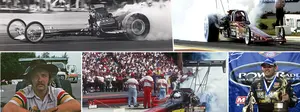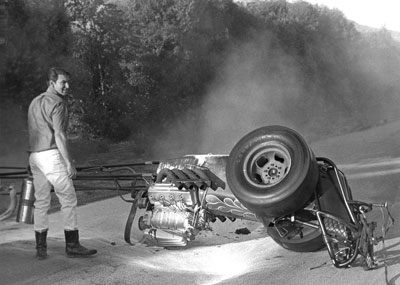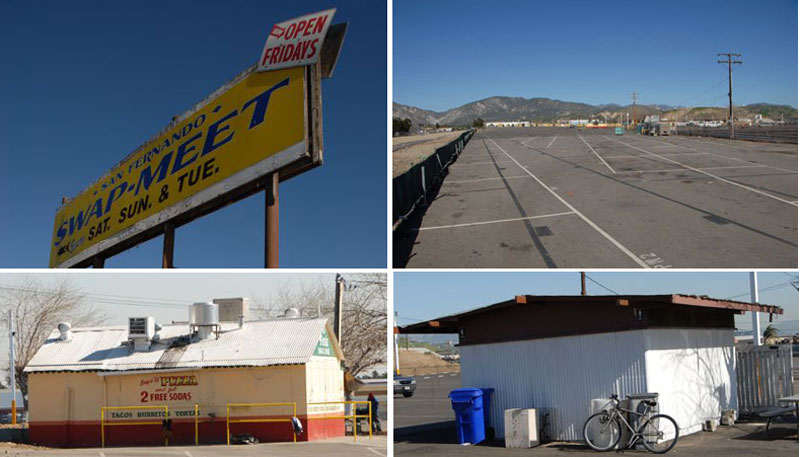

They left their hearts in San Fernando

(Above) Classic tire-melting 1960s Top Fuel action at San Fernando Raceway. (Below) Overall of the track and its famous tree-lined left lane.
|
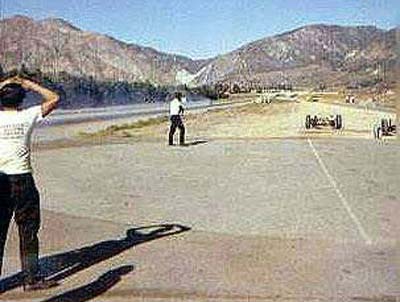 |
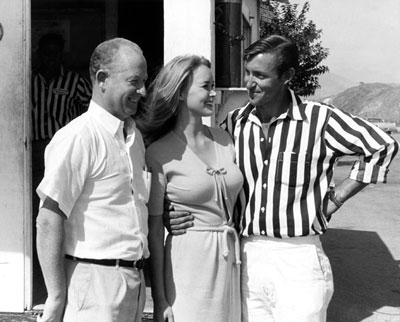
(Above) Longtime San Fernando track manager Harry Hibler, right, with track co-owner Bill Hannon. (Below) Drivers who went off the end of "the Pond" had to drive beneath a bridge, under which was the sand trap.
|
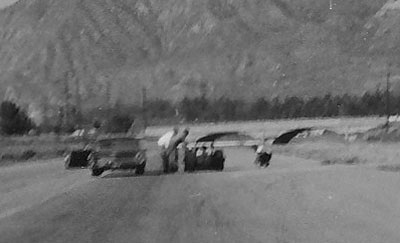 |
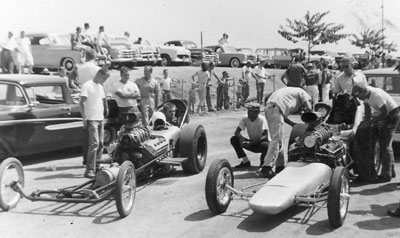
(Above) Fans could watch the action from the elevated spectator parking lot and the comfort of their cars. That's "Jeep" Hampshire on the left and Bill Alexander on the right preparing to fire up. Fans could also see the "hot car" pits (below). The Surfers, "Pond" regulars for years, are at right. At left is the Pegasus dragster of John Harbert. Nobody in the history of
|
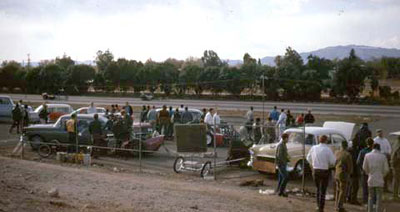 |
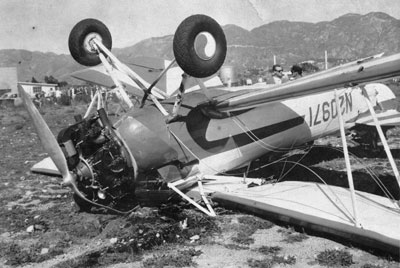
(Above) Errant airplanes trying to land at the adjacent airport sometimes shut down action, but it was all in a day's work for Hibler (below).
|
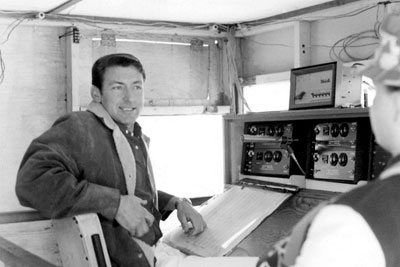 |
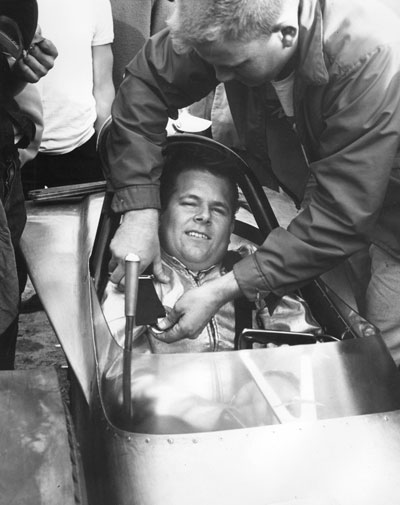
You never knew what you were gonna see at "the Pond." One day, famed engine builder Dave Zeuschel (pictured) switched roles with driver Don Moody to show he could drive as well as tune and raced fellow wrench Ronnie Winkel, who took over for his shoe, John Wenderski.
|
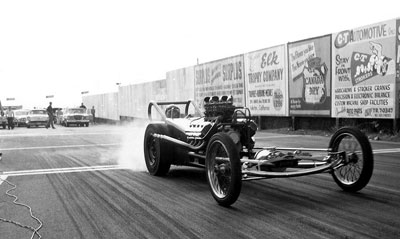
(Above) Here's a rare photo. Dave Wallace Sr. , the track photographer, was instructed not to submit any photo that didn't show the big San Fernando sign, so this print was never sent to any of the racing weeklies. (Below) Another rare image, shot from the left lane, thanks to a single by Zeuschel, Fuller & Moody.
|
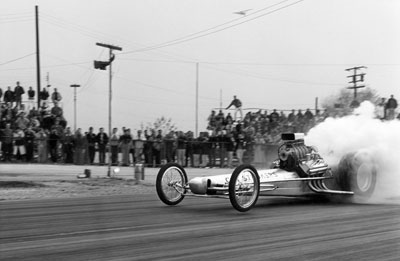 |
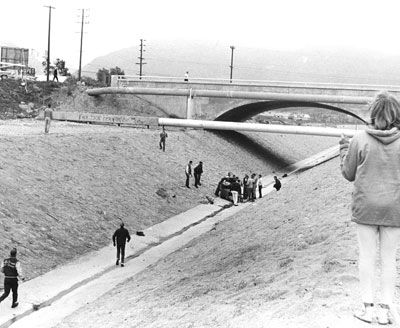
(Above) The perils of "the Pond." A driver who left the track surface to the left might end up in the adjacent wash, as happened here to John Mitchell and his record-setting Jr. Fueler. Note track photographer Wallace, lower left, sprinting to the scene from the starting line. (Below) Wallace's son, Dave Jr. followed Dad into the biz. Here's one of his first pics, circa 1963, of John Wenderski, arguably the fan favorite at his home track. He went directly from an A/Stock 409 Chevy to this Top Fueler (and was killed in it, at Ramona, not long after).
|
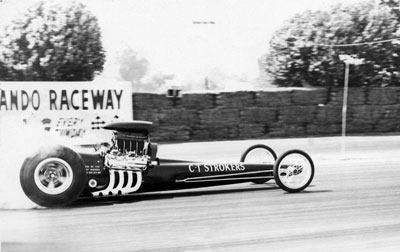 |
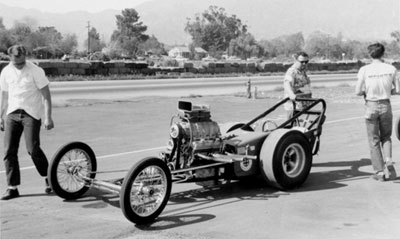
The church responsible for drag racing's first noise curfew is visible directly above and beyond Tommy Ivo's engine in this April 1961 shot.
|
Four days each week, in the modest California city of San Fernando, deep in the San Fernando Valley northwest across the Santa Monica Mountains from Hollywood, wedged in a triangular sliver of land bordered by Glenoaks Boulevard to the west, Arroyo Street to the south, and Foothill Boulevard to the north, hundreds of small operations unload their prized inventory and set up shop to do business at one of the area’s largest open-air swap meets.
But more than 50 years ago, beginning in 1955 through 1969 on this same patch of land, it was dragsters and door cars that were unloaded and shown off to eager customers at a friendly little place known as San Fernando Raceway.
In the long and proud lore that surrounds early Southern California dragstrips, a lot of attention has been paid to legendary facilities such as
Those who ran there, those who watched there, and those who worked there remember it fondly as a little place where anything could happen -- and usually did. Whether it was the unveiling of a new and untested technology, a record-breaking run, or a misguided airplane landing on the strip, something was always happening at the place affectionately known by locals as “the Pond.”
(There was no pond at “the Pond”; the name originated by a racer whose name has been lost to time who said he would rather race at San Fernando than at a more competitive venue such as Lions because at San Fernando he was “a big fish in a small pond,” and once local Olds gasser favorite Dick Harriman proclaimed himself the ”big fish,” the name stuck.)
We’re fortunate that one of the principals of San Fernando Raceway was Harry Hibler, a former hard-luck Top Fuel racer (dubbed “Hand Grenade Harry” for the sometimes explosive nature of his rides) who later became an icon in our publishing world during a 30-plus-year career at Petersen Publishing, where he was the longtime publisher of Hot Rod magazine and thus knows a thing or two about storytelling.
Hibler, a member of the SEMA Industry Hall of Fame, was a tech inspector at the track under the stewardship of Frank Huszar and co-manager (and LAPD officer) Darrell Morgan from 1955 until 1960, when he became the manager. He was the manager until the strip closed in 1969 and provided me with vivid details about the track.
San Fernando Raceway was one of the first purpose-built dragstrips in the country and pre-dated the opening of Lions by a few months. Fritz Burns and Bill Hannon, land developers of such projects as Panorama City, Marina del Rey, and several hotel complexes, owned a parcel of land next to the old San Fernando Airport and built the racetrack in 1955 after Huszar, owner of the famed RCS chassis shop, convinced them and Los Angeles city officials to help find a way to combat the rising scourge of street racing.
“There were several unique features that set ‘the Pond’ apart from most tracks [then and now],” he said. “First of all, the spectator parking lot sat about six to eight feet above the 'hot car' pits and the track itself, so spectators could sit in or on their cars and watch the show or sit in the stands that were located near the starting line.
“The other unique feature and one that was a bit unnerving to some of the drivers running there for the first time was the fact that the track actually went under a bridge at the end of the shutoff area. In fact, the sand trap was located under the bridge, which was nice since it was protected in case of rain. The total length of 'the Pond' was actually more than
“One other thing 'the Pond' had that was great, especially for new drivers, the left-hand side of the track was lined with bushy-type trees that were tall enough for a driver to use as a reference point when he was ‘smoked in,’ but no one who ever drove into them was ever injured. Also, the trees stopped at the finish line, so a driver also knew when to pull the chute. The real reason for the trees being planted where they were was to act as a noise barrier, but you know racers always improvise.”
In addition to being the track manager, Hibler was the ambulance driver, not only for the dragstrip but also in the event of a mishap at the airport; when the ambulance had to run next door to the airport, all racing had to stop.
And even though the racetrack was equipped with the required FAA markings to keep pilots from landing on the quarter-mile, sometimes a wayward pilot would try to land on the dragstrip, sometimes when the cars were running!
“I have heard a lot of stories about the plane that landed on the track during a run by Tony Nancy,” he said. “The fact is the plane did touch down just after Tony cleared the lights, so it didn’t miss Tony's parachute by more than a few feet. The FAA official in that area caught up with me and had me identify the plane and sign a document as such and promptly pulled the pilot’s license.
"Over the years at San Fernando, we had one plane land/crash upside down in the spectator parking lot, two that caught their wheels in the wires at the end of the runway, one that blew a tire on landing and nosed over, and one whose left wheel brake locked when it landed and wound up crashing into one of the commercial buildings at the side of the airport and catching fire.”
Hibler, himself a racer when he was hired, was a racer’s kind of track manager and showed it in many ways. He not only helped racers work on their cars and aided them in borrowing parts from their competitors, but he also warmed their cars when their drivers were MIA and, on occasion, though it was against his orders, would even make a run for a team, not telling his own staff “so they wouldn’t get in trouble if I got caught.”
He never aligned the track with any sanctioning body that courted them because, through the owners, he had plenty of good insurance (which back then was the prime benefit of sanctioning-body affiliation), and as an independent track, they could adapt existing rules to better suit their needs. The track was open for testing during NHRA’s fuel ban and welcomed racers who wanted to try their new innovations that other track managers shied away from as long as they followed the track’s guidelines.
Dick Landy tested his first altered-wheelbase car at "the Pond," and Hibler helped Jim Deist assess the correct mounting location for the parachutes on the first Dodge Chargers “funny cars.”
“We took the car to 'the Pond' one evening, and Jim drove while I rode in the trunk, and when he knocked on the floor, I pulled the release. The first couple of passes, the chutes didn’t deploy well because of where they were mounted, but before he headed back to his shop, we had worked out the details for both the mounting and release positing. My only comment on this is: I should have been strapped in when the chutes finally opened.”
“ 'The Pond' was a place where the racers went to try new ideas out and to compete, but as much as anything else, to have fun,” he continued. “One Sunday, present were the teams of Don Moody and Dave Zeuschel and John Wenderski and Ronnie Winkel. Somehow, in the usual banter about competing, someone said that some of the drivers could build engines, but engine builders could never drive. One thing lead to another, and so I put together a race with Zeuschel driving their car and Winkel driving their car. This turned out to be the highlight of the day as each one of them was in and out of the throttle several times during the run: smoking the tires, lifting, smoking the tires, etc. Everyone there enjoyed this action, from the racers to the spectators, so we repeated this scenario on other occasions.
“Another thing: We always believed the racers were the show, and none of the dragsters, altereds, etc. ever paid to get in the gate. We also had another tradition I don’t know any other track had: Every month, we gave 3,000 general admission tickets to a charity, and they got to keep all of the money they raised from selling the tickets."
“We did in three hours what most tracks did in eight or more hours,” Hibler said proudly. “We ran an eight-car Top Eliminator. Top Gas, and Little Eliminator open shows every Sunday in addition to all of the classes. Everyone showed up early and made runs with the headers closed until 12:30, then they all uncorked until 3:30, and the stock classes then corked up and did eliminations. The racers all knew the drill, so they sometimes watched the clock closer than I did and even went so far as to help a competitor get back to the line in time.
“Our average total number of cars competing each Sunday was over 400 ‘street’ (stock, modified, etc.) cars and 30 to 40 ‘hot’ cars (AA/F, AA/A, etc.). The most outstanding day I can recall was after two weeks of the annual PDA meet at Lions being rained out on Saturday night along with Irwindale,
“One of the people I respected most in the sport was 'Pappy' Hart, and every time we got together, his first question was, 'How do you get so many cars down the track in three hours?' I don’t believe I ever really answered his question.”
Tom Jobe, a third of the successful 1960s Top Fuel team the Surfers – along with Mike Sorokin and Bob Skinner – who were regulars at San Fernando, remains in awe of Hibler’s efficiency.
“How Harry Hibler could run that show so well without a harsh word to anyone always dazzled me,” he said. “Legendary stuff, done by a legendary guy.
“We always tried to race two days a week if possible to try out our ideas and get in more experience. That often meant running at
“For anyone that missed the
“The local [noise ordinance] made for a quick three-hour thrash to warm it up, get in a qualifying pass, and make the three runs of an eight-car show (assuming you got to the final round). This might sound hectic, but it was no big deal for most of the competitors. The toughest part of the deal was the ferocious competition you faced and the fact that there was no break rule in those days, so when you got beat, you were done for the day.
"Life's worst fear? In my mind was getting paired up with Brissette's car in the first round because you knew Brissette's car could make one pass hazing the tires right through the lights going five or 10 mph faster than any other car at the track had ever gone ... no one was ‘saving it for tomorrow’ because everyone had at least five whole days and nights to get ready for the next weekend.”
(One memorable story about the Surfers at "the Pond" that Hibler recalls was the team winning Top Fuel one day with a cardboard patch duct-taped over a hole in the block. They ran the final with a couple of cylinders with no pistons in them.)
The Brissette car that Jobe referenced was the Brissette & Sutherland entry, tuned by still-active nitro wrench Jim Brissette and driven by Paul "the Kid" Sutherland, who were the scourge of local Top Fuel racing and at San Fernando made a still-well-remembered world-record pass of 219.54 on Oct. 3, 1965 after running 216.34 the weekend before. "The rest of us were hard-pressed to run 209," recalls Jobe.
Still, track management had other challenges beyond errant airplanes. The track had just eight paid employees (the remainder who helped run the events were volunteers) and operated on a pretty low budget, and although Top Fuel paid $250 (and a case of oil) to win, some racers were beginning to find it hard to make ends meet.
Hibler – “everyone’s hero,” as Jobe dubbed him – displayed the skills that later would make him a great advertising salesperson as he hustled up giveaway products, including oil, spark plugs, tools, and other goodies, to supplement the winnings, and sometimes he even dug into his own pocket “to give a racer 25 or 30 bucks to get home on.”
For the Surfers, that tipping-over point came in 1966. “It was a very sad day when our per-run cost got to $62.50 and we had to win just to break even,” said Jobe. “We never went back to
The Surfers weren’t the only ones feeling the pinch of the increasing cost of being competitive. Gradually, the number of cars competing at "the Pond" dropped to 10 to 15 fuel and gas dragsters.
“The good news then was that there were so many cars that were always being built and tuned that there was always a good show at 'the Pond,' but the name guys were harder to get there simply because they could make more money at other tracks,” said Hibler.
Yet the fans loved the place. Steve Quercio, who was John Force’s earliest marketing guy and who sold Drag News at
“Man, was it a treat to see the likes of Pure Hell or Warren- Coburn-Miller, Ivo, or 'the Snake' show up on a Sunday. We really never knew who would be there, mainly guys that ran ‘the Beach' on Saturday night. Man, those were really the good old days! Brissette, Sutherland, & Yates popping blowers for like 10 straight weeks, then they finally hit that 219 mph, or George Tuers putting his car in the ditch, but the thing I remember the most was ‘Flaming Frank’ Pedregon and that wild coupe! He was the nicest guy you could ever meet. I remember the station wagon, with his wife and his kids [Tony and Cruz] that were maybe seven years younger than me. Who in the hell would ever think those two kids would be where they are now? Same with Larry Dixon [Sr.] with the Howard Cams Rattler or the Fireside Inn and that other little kid in the stroller.”
Cliff Morgan, who has been a fan for decades and corresponding with National DRAGSTER for as long as I’ve been here, grew up in nearby
“I went to a lot of other tracks, like San Gabe, Lions, Irwindale, OCIR,
“One race that comes to memory was Barry Kaplan in the Super K Jr. Fueler running against Don Prudhomme’s AA/FD in late 1968. ‘The Snake’ had debuted the car at that race, ran a 7.49 half pass. Anyhoo, they raced in Top Fuel, and ‘the Snake’ got sideways and had to shut off, so Kaplan won. Everyone talked about that for weeks! The track closed in 1969. We went out there one day, and the gate was padlocked. Next week, the same thing. No last race; it just closed, and that was that.”
For 15 seasons, San Fernando carved a legacy all its own, but, as was the case with just about every Southern California track, the region’s urbanization spelled a death knell for "the Pond," and other factors contributed to its late-1969 closing.
|
|
“There were more people moving in around the track to live, and as a whole, they were becoming more and more hostile about the noise,” recalls Hibler. “The other main reason it closed when it did is because construction had started on the 210 freeway, and there was between 300,000 and 400,000 yards of dirt to get rid of. The track owners made a deal for them to dump it, grade it, and compact it on the racetrack itself, which resulted in leveling the entire property off with the parking lot level and increasing the value of the place by a couple of million dollars. They cut the deal as a last-minute thing and had to start accepting the dirt immediately, so they told me to just shut it down.”
My journalism colleague and historical go-to guy, Dave Wallace Jr., who probably has forgotten more history than this column will ever print, worked at San Fernando beginning at age 12 (and supplied info and many of the photos that accompany this article from his own and Hibler’s files), also blames another source for the drag racing’s racer and fan doldrums: the Vietnam War.
“More than 2.5 million of us served there,” Wallace said. “The peak occurred at this very time (1969), with more than 500,000 troops there simultaneously. Moreover, for every serviceman actually stationed there, approximately 2.5 others were necessary in ‘support’ roles. By the end of 1969, the Vietnam-era draft had been going hot 'n' heavy for more than five years. Starting around late '67, you could see the results by declining numbers of spectators and, especially, stockers in the staging lanes. LBJ started drafting virtually every able-bodied male who hadn't carried 12-plus units -- continuously -- of college immediately following high school. Full-time college students were exempt, so the vast majority of soldiers were, like me, lower-to-middle-class, blue-collar kids, averaging 19 years ‘old.’ Needless to say, that's the same group of baby boomers responsible for booming drag racing and muscle cars in the mid- to late '60s. All of this affected ALL dragstrips, but the smaller tracks were more vulnerable because they depended more heavily on the 'back' gate (vs. spectator income from pro shows).”
|
|
“Over the years,
The good times at San Fernando Raceway may have ended and the laughter died a little bit when the track did, but it’s clear that the memories live on in the hearts of those who left theirs at
|
|



















































